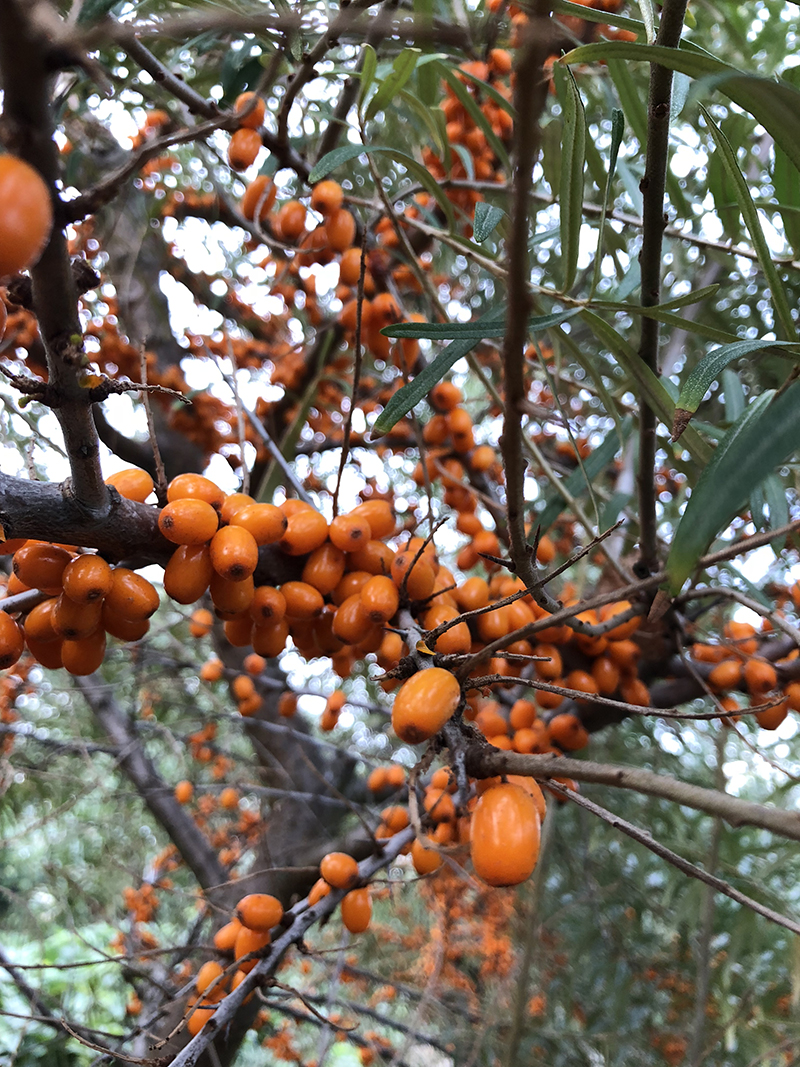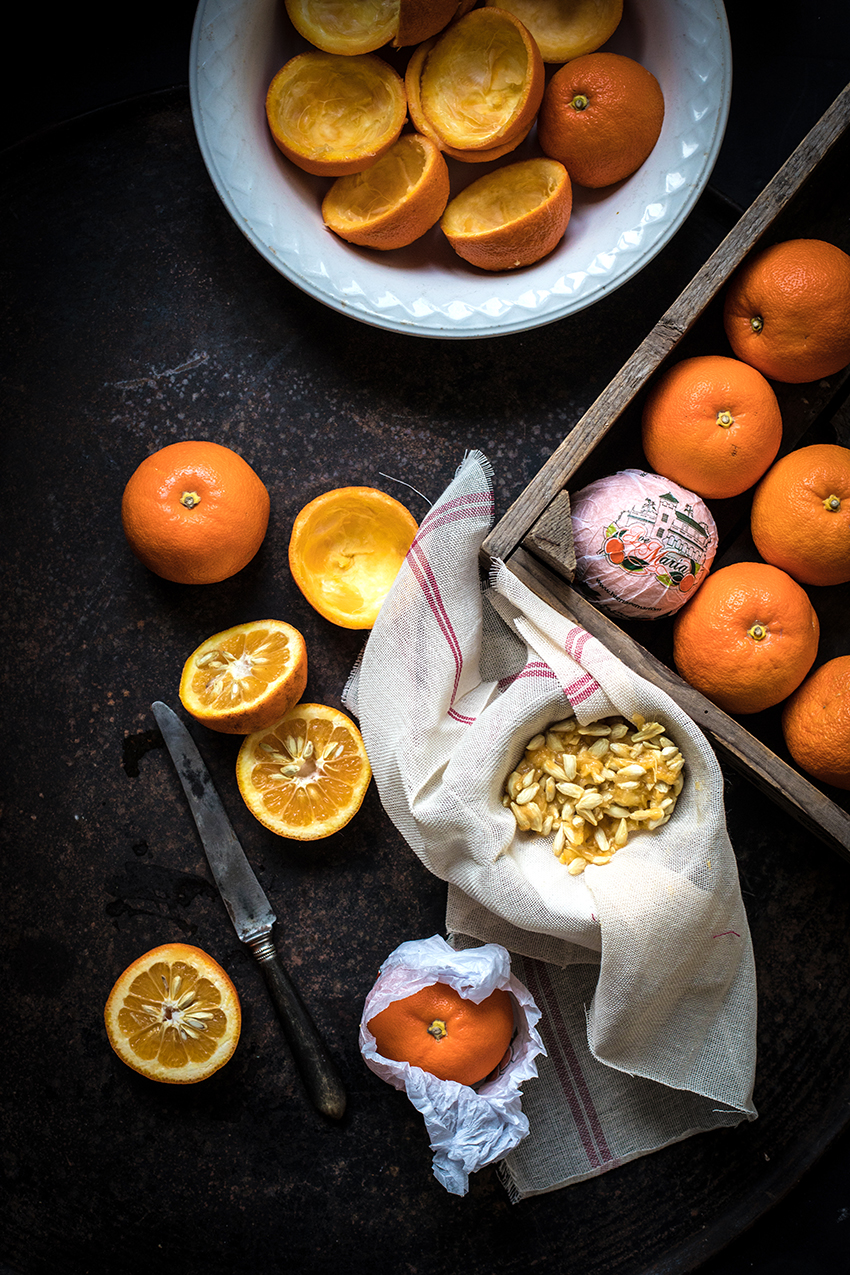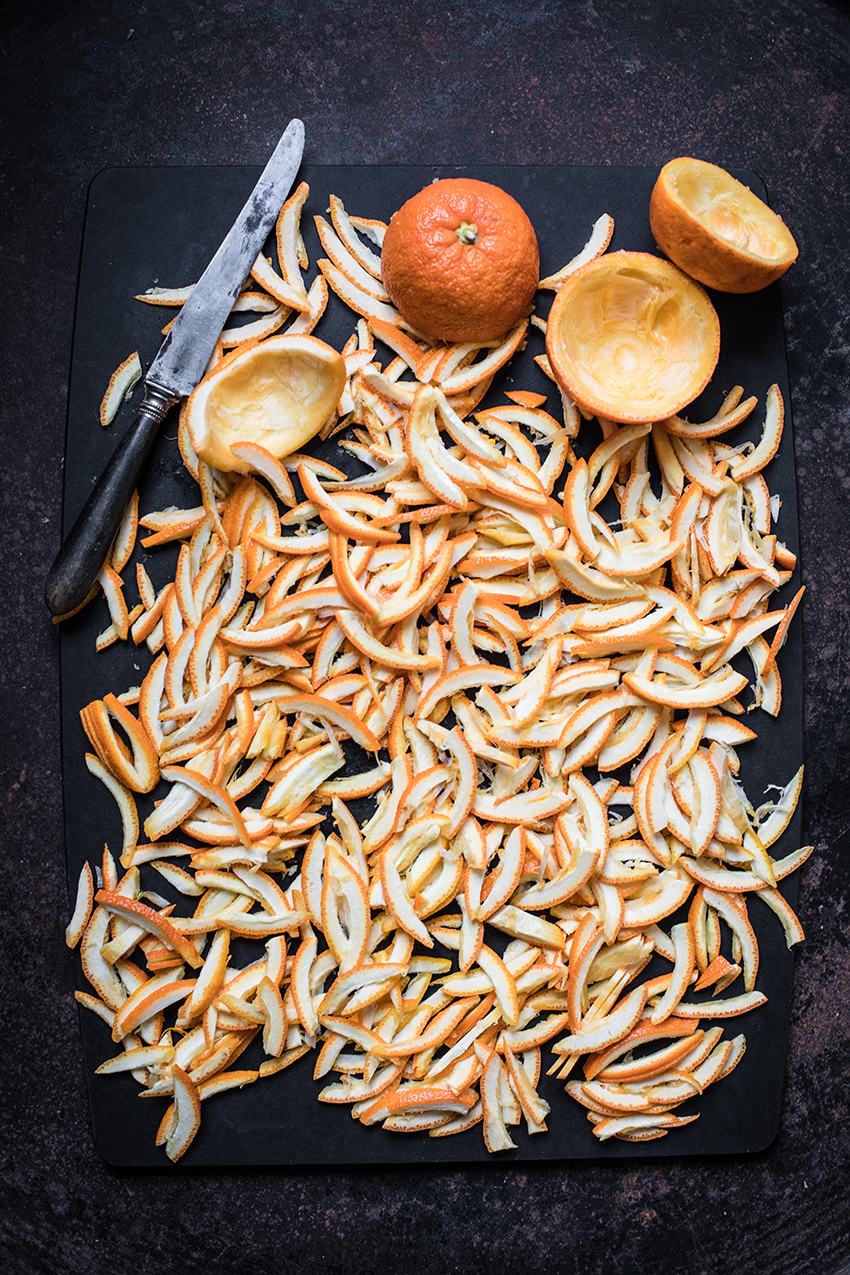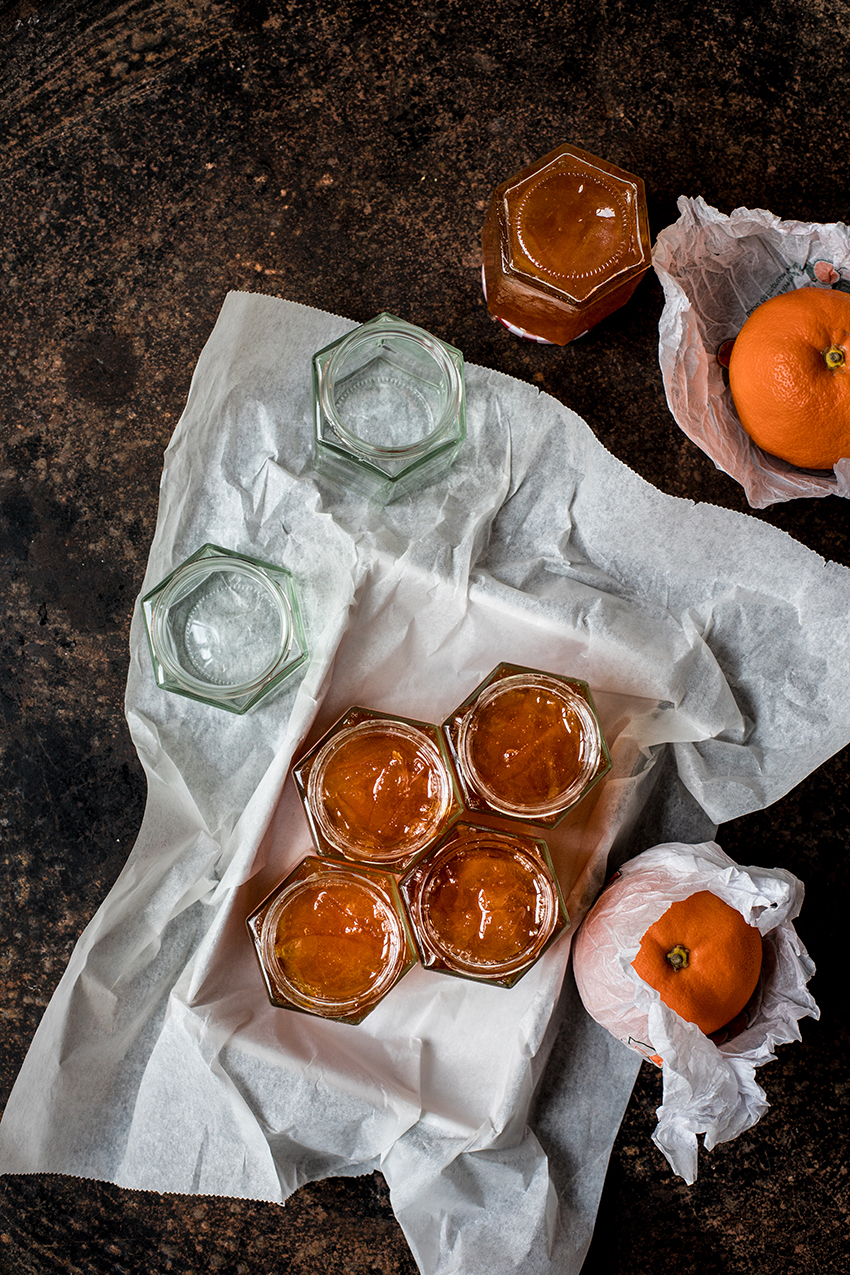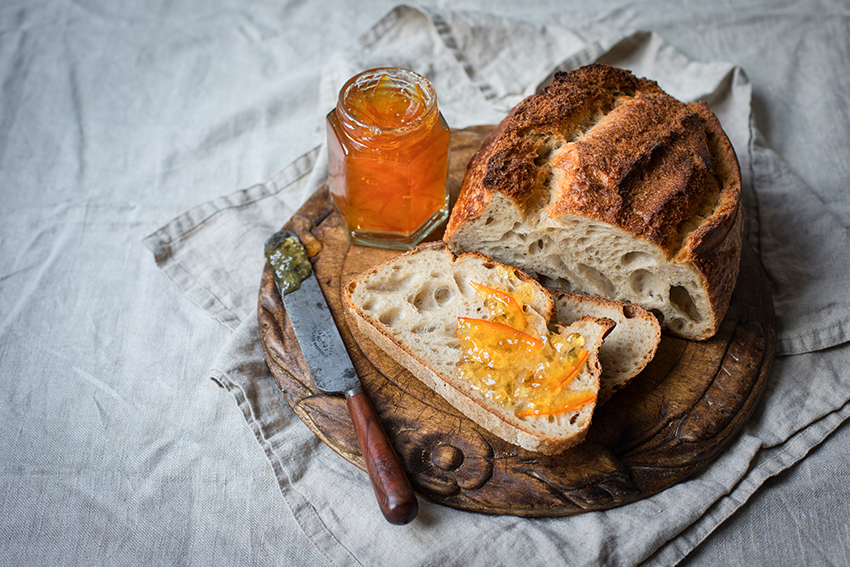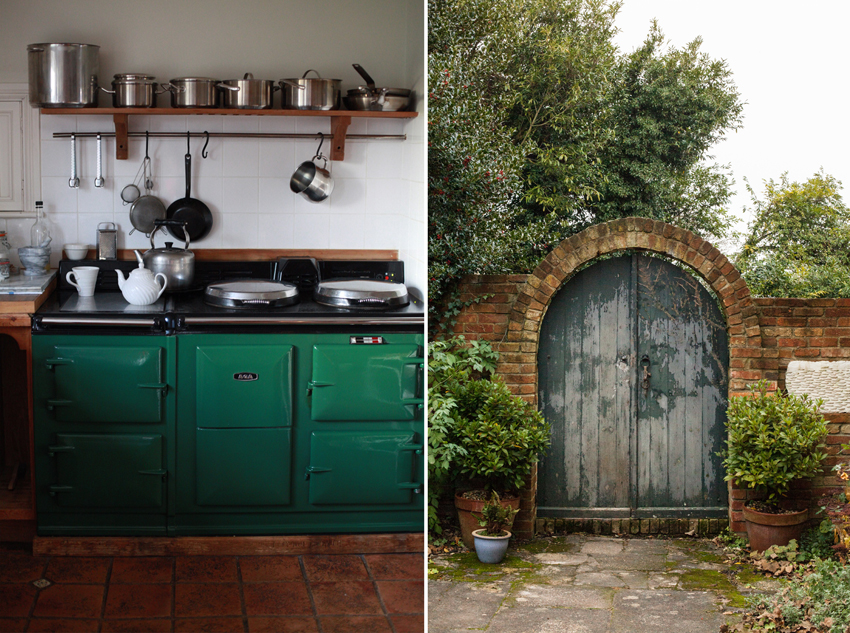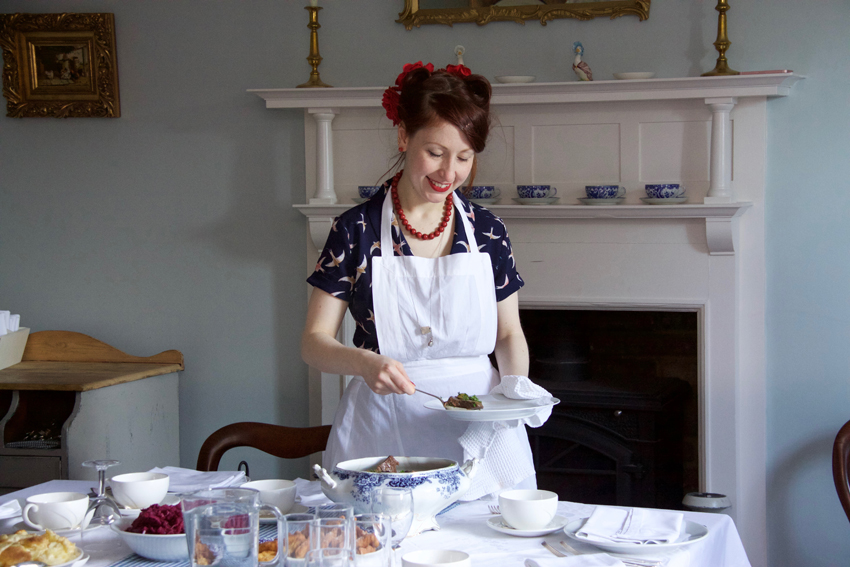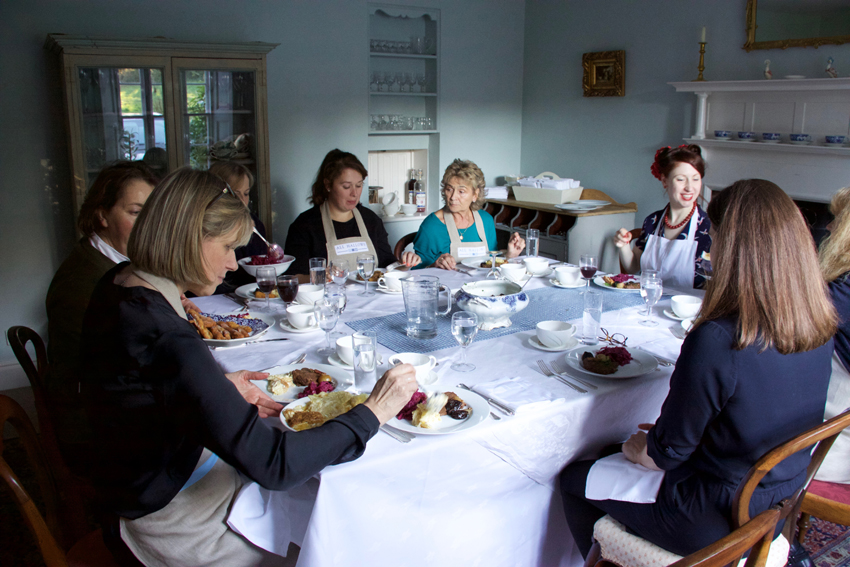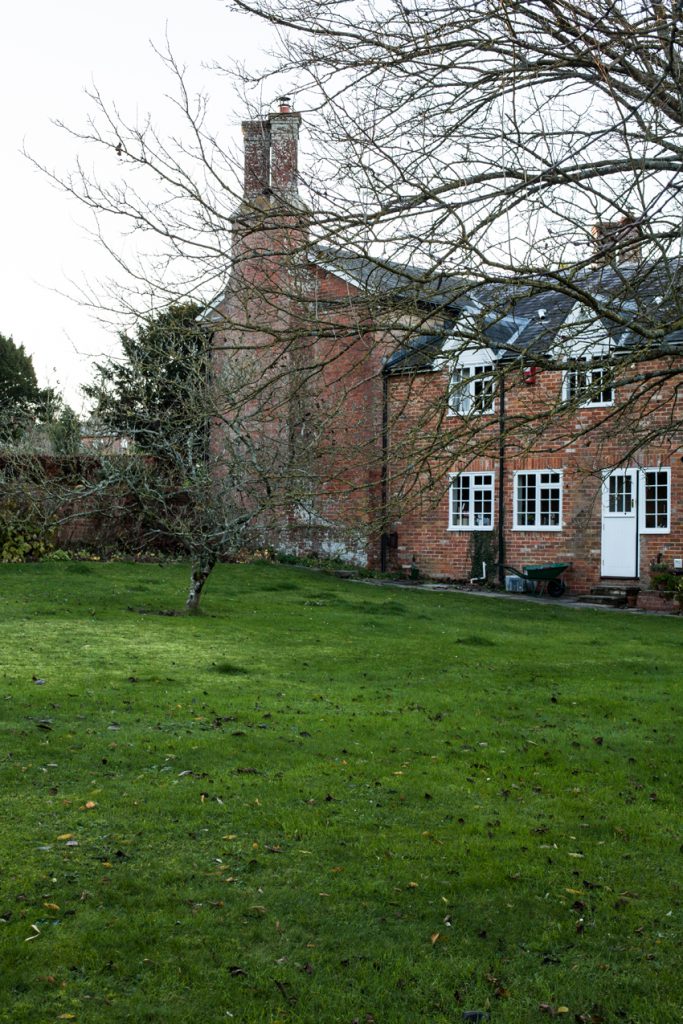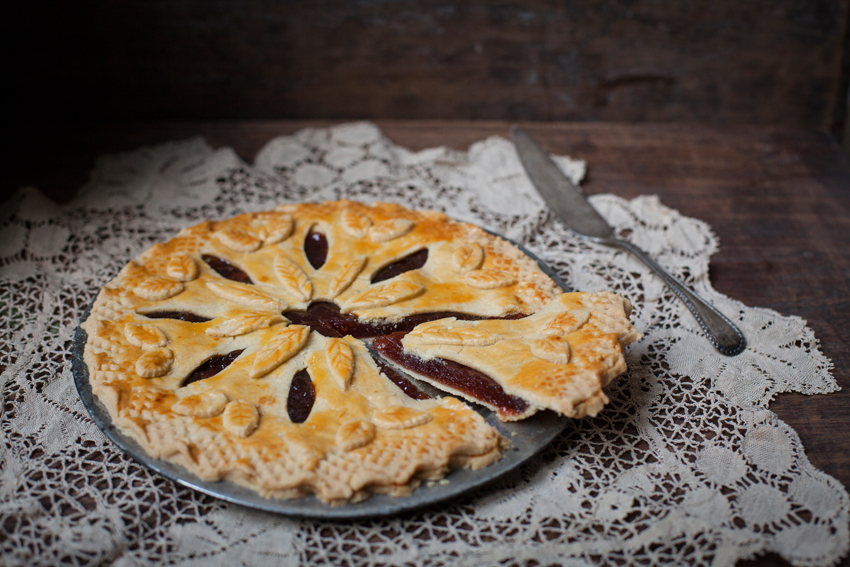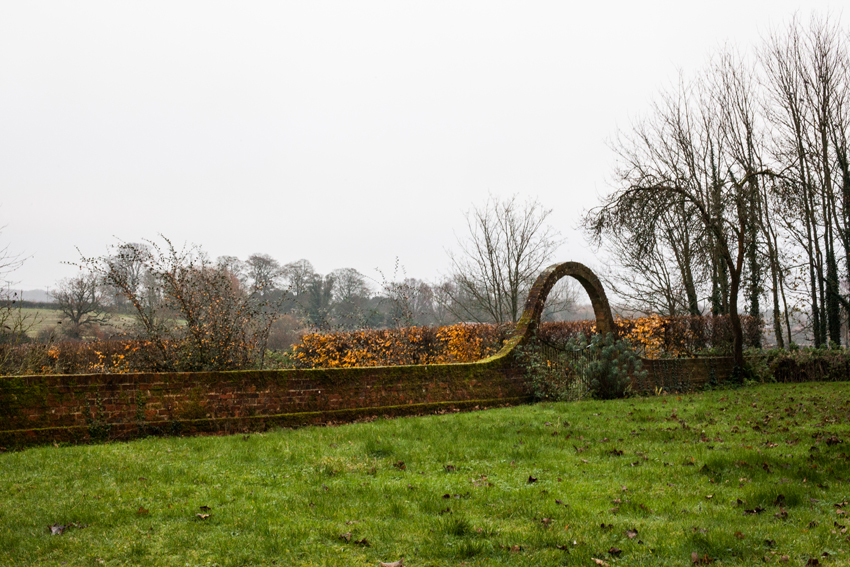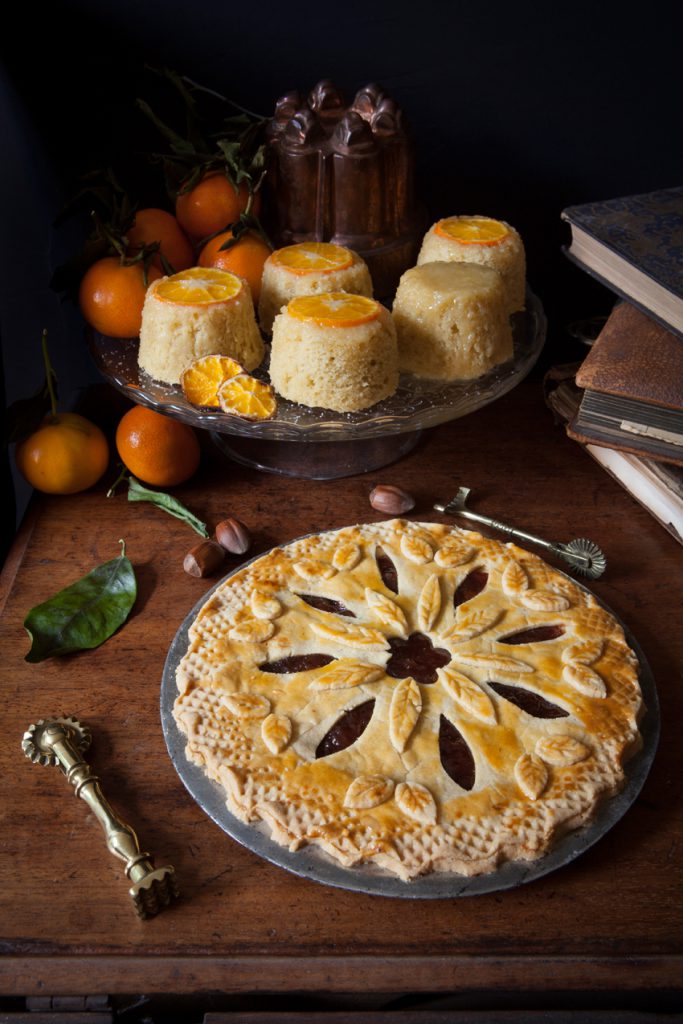The post Sea Buckthorn Berries and Various ways with them in the Kitchen appeared first on Miss Foodwise.
]]>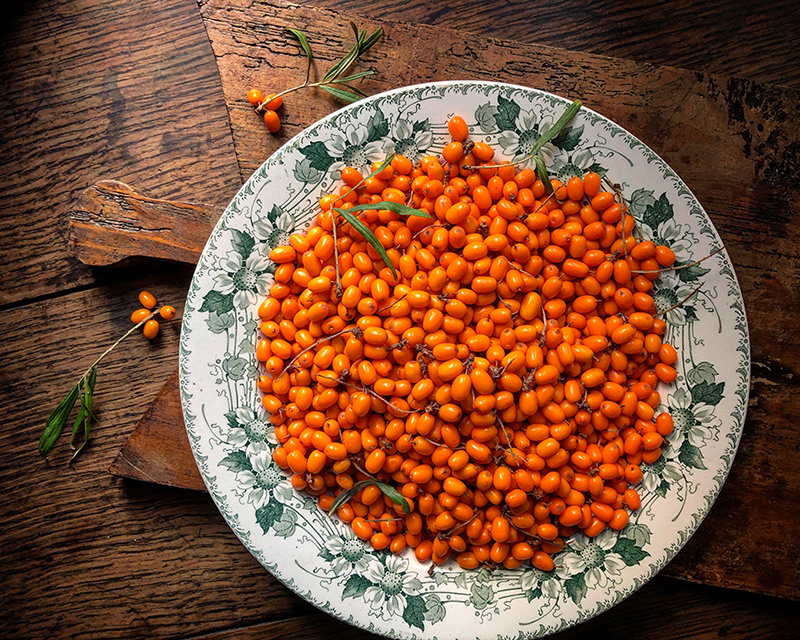 I first came into contact with these bright orange berries on one of my trips to Sweden last year. We visited a pick your own farm where the hedges of Sea buckthorn were plenty and laden with fruit. I wondered where these rough looking shrubs with their vicious thorns as dangerous as barb wire normally grow. Sea Buckthorn grows in coastal areas in Europe and Asia, in dunes and on moors. Their Flemish name translates to ‘Dune thorn’, other names are Sand Thorn and Siberian pineapple. Their roughness reflects the landscape in which they thrive. Brisk winds and cold, draught, desolate plains. Their root system is invasive, but improves marginal soil. In some areas the bushes have even been used for soil erosion control and land reclamation projects. It sort off feels like their thorns tell us to let them be, so that they can do good for the surrounding earth, the wildlife and to bring a highly healthy berry to the people that live around them. Birds can nest in the branches, benefiting from the piercing thorns as protection agains predators.
I first came into contact with these bright orange berries on one of my trips to Sweden last year. We visited a pick your own farm where the hedges of Sea buckthorn were plenty and laden with fruit. I wondered where these rough looking shrubs with their vicious thorns as dangerous as barb wire normally grow. Sea Buckthorn grows in coastal areas in Europe and Asia, in dunes and on moors. Their Flemish name translates to ‘Dune thorn’, other names are Sand Thorn and Siberian pineapple. Their roughness reflects the landscape in which they thrive. Brisk winds and cold, draught, desolate plains. Their root system is invasive, but improves marginal soil. In some areas the bushes have even been used for soil erosion control and land reclamation projects. It sort off feels like their thorns tell us to let them be, so that they can do good for the surrounding earth, the wildlife and to bring a highly healthy berry to the people that live around them. Birds can nest in the branches, benefiting from the piercing thorns as protection agains predators.
The oval berries are tart, bitter and have little sweetness to them. They have been used for medicinal purposes for centuries, they are full of anti-oxidants, beta-carotene, vitamine C, A and E and they battle inflammation. A concentrated puree from the berries can be used to relief sunburn and some say it could be good for some skin conditions. You could call them a super food, but lets forget about that horrible hipster term shall we? The young leaves can be used for tea because of their amino-acids, fatty acids, minerals and ability to boosting the immune system. An oil is made from the berries and seeds and used for all kinds of ails. In a nutshell, the berries are good for you and the shrub is a good one to have around.
I enjoy the flavour, the mild tartness, their lack of sweetness. I bought a jar of Sea Buckthorn jam on my last trip to Sweden when I visited an apple orchard by the Baltic Sea. Of course because of their location they must have had a lot of Sea Buckthorn bushes around and in their shop they sold a jam called “Marmalat” which was more compote textured than jammy because they added a small amount of apple to the Sea Buckthorn. The jam was spread on toast and the jar empty much too soon so I started to look forward to the new Sea Buckthorn season and searched for a farm that grows the trees.
On an evening in late august my husband and I set out to visit a man with a passion for peculiar and otherwise difficult to find fruit bushes. Together we spent nearly half an hour harvesting just 500 grams of berries. The cruel thorns make harvesting very troublesome and the tree doesn’t like to let go of its berries very easily. The best method to harvest these berries and to prevent cuts in your hands from the thorns is to prune the bushes – that need a lot of pruning anyway – and freeze the branches whole. When frozen the berries are suddenly incredibly easy to pick and most just fall from the branches.
I wanted to make the jam and at the same time make as much of the fruit as I could. The jam was made by boiling the fruit, then straining the pulp. The pulp just keeps on giving, to the pulp of 500 g berries I added 1 liter of boiling water and left it to brew for half an hour. The juice that is left can be consumed as tea or juice and it is also makes a very good aperitif mixed with sparkling wine. My favourite thing to do with the juice however is to make a sorbet out of it. I’m not an ice cream lover because I’m not too fond of its sweetness but since these berries aren’t really sweet it makes for a perfect sorbet for me. Just freeze the juice in a shallow container and stir every 30 minutes until ready – or use a machine if you have one. Come to think of it, a slushy would work great too!
In cooking the berries can be used with white fish or even with venison or slow roasted lamb as a tart note. I can not wait to make a spicy pickle from them. This plant is versatile and I’m planning to plant a few of these bushes in my new garden whose soil is completely depleted by the bamboo and the plastic grass mats on top of it… yes, we got fake grass but not for long, I hope!
If you can get your hands on these berries, here is my recipe for the jam I so adore:
What do you need
- 5oo g berries, rinsed well
- 500 g jam sugar
- 1/2 lemon, juice only
- 1 eating apple, in small cubes
Method
Prepare some sterilised jam jars and put a saucer in the freezer.
Stew the berries with a splash of water so that they pop and juice is forming, sieve the juice and put aside the pulp for other uses stated above (tea, juice, sorbet, a cocktail mixer).
Add the apple sugar and lemon juice to the pan with the juice and proceed as for making jam. To create a smooth jam you can blend the jam using a stick blender and then proceed to reduce it until it thickens. Test the set by putting a blob of jam on the saucer you put in the freezer earlier, if it sets, you’re done, otherwise test again every 5 minutes.
Pour the hot jam carefully into the jars, close and invert (don’t invert if you don’t usually do this and use other methods)
The post Sea Buckthorn Berries and Various ways with them in the Kitchen appeared first on Miss Foodwise.
]]>The post Bitter Seville Orange Marmalade – A Potted History and How to Make it appeared first on Miss Foodwise.
]]>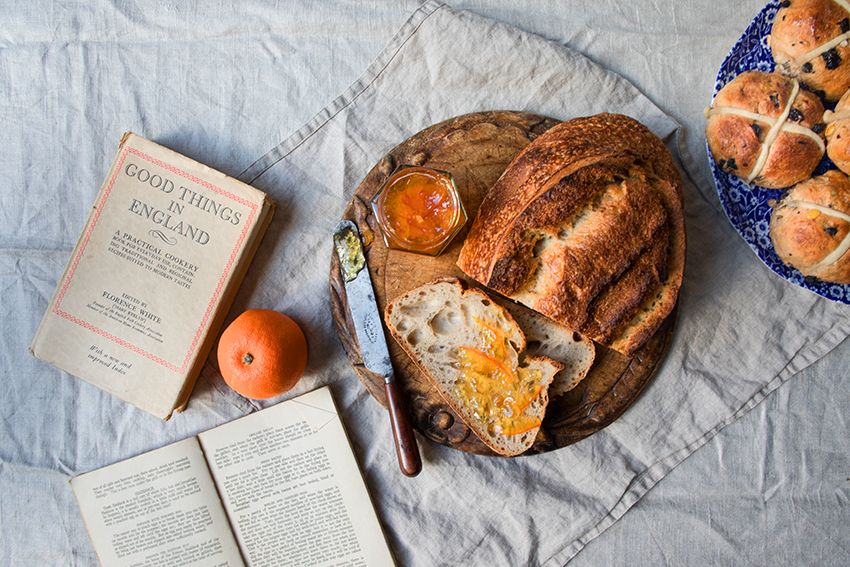
Marmalade is like Marmite, you either love it or loathe it.
Marmalade is loved in Britain, smeared on golden toast as the last course of the English Breakfast. The humble jar of sunshine even has its own Marmalade Awards each year in Cumbria in the North of England. Anyone can send in their jar to be judged by marmalade royalty, and my friend Lisa from All Hallows Cookery School in Dorset just won with hers.
In a time when bitter flavour is bred out of vegetables and fruits, you would think many people are not that fond of marmalade. Marmalade is traditionally made from bitter Seville oranges. Originally from Asia, the Moors introduced these oranges in Spain around the 10th century. They are quite inedible in their raw state and if you can manage I salute you. Because of their sourness Seville oranges contain a high amount of pectin. In 17 and 18th century cookery books they get a mention as ‘bitter oranges’ and it wouldn’t be an British classic without a story.
The legend
In the mid 18th century a Spanish ship carrying Seville oranges was damaged by storm. The ship sought refuge in the harbour of Dundee in Scotland where the load deemed unfit for sale were sold to a local merchant called James Keiller. James’ mother turned the bitter orange fruit into jam and so created the iconic James Keiller Dundee Marmalade. It wasn’t a coincidence that James mother made marmalade, in the 1760s her son ran a confectionery shop producing jams in Seagate, Dundee. In 1797 he founded the world’s first marmalade factory producing the first commercial brand of marmalade. In 1828, the company became James Keiller and Son, when his son joined the business. Today you can see stone James Keiller and Son marmalade jars pop up at every carboot sale and antiques market. But the marmalade is still in production, only now in glass jars that off the beautiful radiant orange colour that is so typical of marmalade.
The truth as clear as marmalade
According to Ivan Day, a prominent food historian who I was lucky to do a course with, one of the earliest known recipe for a Marmelet of Oranges dates from around 1677 and it can be found in the recipe book of Eliza Cholmondeley held in the Cheshire Archives and Local Studies.
The earliest recipe in Scotland is titled ‘How to make orange marmalat’ and dates back 1683. It can be found in the earliest Scottish manuscript recipe book which is believed to have been written by Helen, Countess of Sutherland of the Clan Sutherland. The book is dedicated entirely to fruit preservation and jelly making. According to The Scotsman “The Countess was married to John Gordon, the 16th Earl of Sutherland, an army officer who was honoured following the defeat of the 1715 Jacobite rebellion.”
This bit of information transports me right to the wuthering heights of Scotland.
This early Scottish as well as English recipe debunks the myth that mother Keiller invented marmalade. Recipes for similar preserves even date back earlier in history. But the Keiller family definitely deserve a prominent spot in marmalade history.
But why do we call it marmalade and not jam?
As you maybe remember from my posting about ‘Quince Cheese’ here > , quinces are responsible for the word marmalade as their Portuguese word is ‘marmelo’ and they were made into fruit cheeses named marmalades. In Spain they call it ‘Membrillo’. Quince just like bitter Seville oranges, contain a lot of pectin and they are both too sour to eat raw. From both of these fruits the pips and peels are used to get a good set, and if you don’t have quince you could easily make a fruit cheese out of these oranges.
If you’re a marmalade fan, chances are you have a particular favourite. You either love every jar that you can find on your breakfast table or you prefer either thick cut, thin cut, or vintage. The cut of course refers to how thick the peel is cut, I like mine as thin as possible. Vintage is a jar you left in the back of your preserve cupboard to age and turn dark amber in colour and deep in flavour. Then there are two kinds I don’t really want to include in the different types of marmalades and that is the flavoured kind, this could be spices, whisky or any other type of booze. I can understand whisky and grand marnier, but as I’ve made marmalade with cardamom, I have to conclude that that jar was something entirely different to marmalade. When it comes to preserves I’m quite the purist. If additions flavour and not just compliments the taste of the fruit, it’s a big no no for me.
What makes a marmalade
There is something to be said about sugar as well. Some use plain white sugar, others use demerara (cane sugar), others use molasse or jam sugar (minut sugar). You don’t need the added pectin of jam sugar, I find molasse to be too dominant, white sugar from sugar beets is something I hardly use except for jam so I decided to use 2/3 of plain white sugar and 1/3 demerara. I don’t want my marmalade to be dark in colour, I want it to be beautifully bright orange.
And finally the fruit… without wanting to be a food snob, organic or untreated bitter oranges are your only option. Remember that you will be using the peel so your fruit needs to be of the best quality. Many Seville oranges are harvested from trees which grow by the road and in the city. These are dirty oranges. I like to know what I put in my jam jar so it’s better to be safe and buy organic. This isn’t sponsored in any way but I’ve found Ave Maria is a farm that sells organic Sevilles, they are stocked in some British supermarkets (ask them on twitter).
I’ve looked at a couple of recipes and the ingredients and method is usually identical. Before I share my recipe (which is identical to many out there) I’ll leave you with some links for you to look at.
Felicity Cloake for The Guardian: How to make the perfect marmalade >
Giulia Scarpaleggia, my dear Italian friend who has access to the best oranges and makes this marmalade every season in big batches: Bitter Orange marmalade and nothing else >
Orange Marmalade
What do you need
- 1 kg bitter organic oranges (no compromise!)
- 1 large lemon
- 2,5 l water
- 500 g demerara sugar
- 1500 g castor sugar
Equipment
- Stainless steel pot
- Muslin
- a selection of sterilised jars
- a juicer if you have one
- a jam thermometer
Method
(I like to do the prep the evening before, then let it sit overnight, you can however do it in one day)
Juice all your oranges and the lemon, keep the pips and all the bits aside. Place the square of muslin cloth in a bowl and crape the pips and bits into it, close with a twine long enough so you’re able to tie it to the outside of the pot.
Finely slice the peels of the oranges, the thickness is your choice, I like the thinnest I can manage and use my sharpest knife for this. Transfer the shredded peel to the pot, tie the parcel of muslin to the pot and pour over the juice and the water then bring to a boil and leave to simmer for 2-2,5 hours. This is to soften the peel, if you like a bite to the peel, check regularly from 2 hours towards the end of the cooking time.
Leave to cool then remove the muslin parcel and squeeze it as hard as you can to get out as much of the juice as you can.
Now to make the marmalade bring the juice back to a simmer and add the sugar, stir well until it is completely dissolved. Bring to a boil, place a saucer or two in the fridge or freezer and check the temperature to reach 104 degrees – which is when the jam should be setting. Test a bit of jam on one of the cold saucers to see if it sets, if not, continue to boil and try again, and again if needed.
When the marmalade is setting, leave to cool for a few minutes before filling your jars.
After filling I still invert the jars because that is what my grandmother and mother did, but you can add wax or boil again in the jars, whatever method you’re used to.
Use on your hot toast or in cakes or puddings!
Next week… Hot Cross Buns revised!
The post Bitter Seville Orange Marmalade – A Potted History and How to Make it appeared first on Miss Foodwise.
]]>The post Quince tart and our workshop in Dorset appeared first on Miss Foodwise.
]]>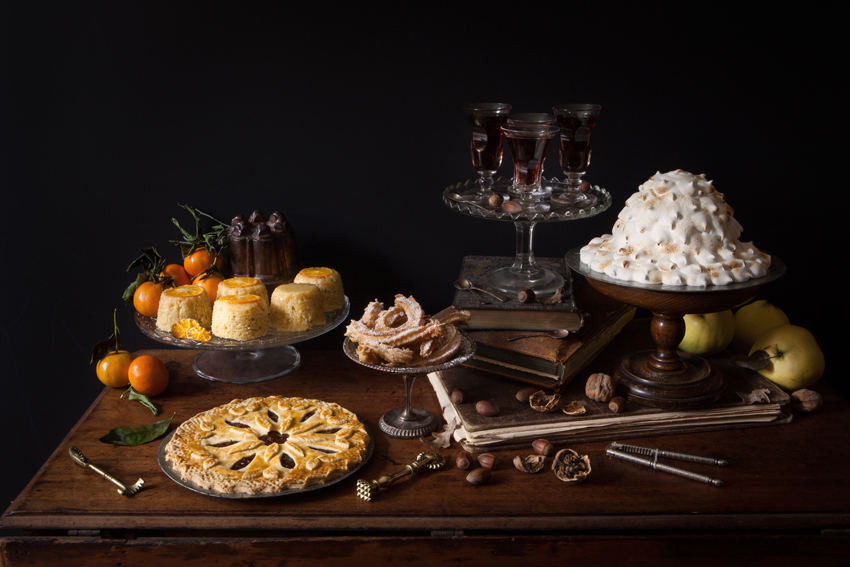
A still life of puddings I created for Borough Market Life Magazine – featuring the quince tart
Two weeks ago on a frosty yet sunny winter morning, we welcomed our workshop attendees at All Hallows Cookery School in Dorset. We started with tea and mini mince pies plus pancakes from the AGA for the early birds. It was hard to get started because we were all having so much fun getting to know each other, or catching up. We made the more delicate puddings from my book, a sweetmeat pudding – otherwise known as the Bakewell pudding, Snake fritters and a quince tart with intricate pastry work. Lunch was beef with prunes, lovingly prepared by our host and owner of the school Lisa Osman. I can’t think of a dish more fitting on a day of English cooking. After all, beef and pudding have been the icon of English food for many centuries. There was a time during the Napoleonic war when eating roast beef and plum pudding would have showed your patriotism. Visitors from all over Europe spoke with high regard about the quality of English meat and beef especially.
After our rather festive lunch in Lisa’s beautiful dining room which made me feel as if I was in a Jane Austen novel, she taught us wreath making which sounds far more easy than it actually was. We struggled and have a huge respect for wreath makers now. We all concluded we now understood why a impressive wreath is so pricy. It takes a ton of work, and will leave you with very painful hands. I finished mine at home and now have it on my front door for all to see.
We are planing more workshops at All Hallows Cookery School in the new year, so if you fancy coming to one, or gifting a workshop to a loved one, then do get in touch with Lisa. All Hallows also has a couple of beautiful rooms so you can make a weekend out of it, or if you’re in the area you can just stay at the house as she is available for bed and breakfast when she has availability.
Now on to that quince tart. I had made the quince jam at home as it takes a couple of hours to make and we didn’t have the time to do that on our day in Dorset. As I said in my previous post where I gave the recipe for quince cheese, you can use that recipe and just not let the jam dry in the oven to become paste. You can dry a part for quince cheese, and use the rest for a tart. But what you also can do is make the filling especially, and then you can use less sugar.
Elaborately decorated tarts like this one were all the rage in 17th century England. Oliver Cromwell the puritan and general partypooper would not have been pleased to see this luxurious tart on his table. He wanted people to eat more simple no-frills meals in order to be closer to god. The whole story about these kind of puddings you’ll find in my book of course. But for now here’s the recipe.
Quince tart
While the original historical recipe uses slices of quince and a syrup made out of the cooking liquid, this version using a jammy quince puree is much more to modern tastes. I’m pretty sure however that they made the same tart this way too. Why wouldn’t they!
The trick to get a beautiful dark colour is to cook the quince and the jam slowly and for a long time. The peel I’m told is also adding to the reddish colour so I never peel the fruit. I do’t remove the cores, because there is a lot of pectin in the pips to thicken the jam. But you can of course peel and core, it’s just not worth the hassle!
What do you need
Makes a 20 cm tart – I find using a enamel plate gives a better result than a pie or tart casing.
- 1 quantity shortcrust pastry, recipe in my book, or use high quality all butter pastry from the shop*
*If you are using store bought pastry you need to buy two packs if you want to make a pastry lid as well. - 3 large quinces, 600 g, roughly chopped each
- 1 cinnamon stick
- 2 cloves
- peel of 1 lemon
- 350 g raw sugar
- 1 egg, beaten, for egg washing
Method
Prepare the shortcrust pastry as instructed in my book or use shop bought. If you are using a pastry lid, don’t blind bake the pastry base. Line the pie dish with the pastry, leaving enough pastry on the rim to fasten the lid to.
Preheat the oven to 160C (315F).
In a large saucepan cover the quinces with water and boil until tender with the spices. Remove the quinces from the saucepan and save the spices (you might not even find the cloves and lemon peel as they can have disintegrated. Just remove the cinnamon.
Blend to a puree using a stick blender. Proceed as for making jam adding the sugar, put the cinnamon back in, being careful as quince jam tends to spit. A way around this is to not make the jam on a hob but first bring it to a boil and stir for 5 minutes, remove the spices, then transfer the pan covered in greasproof paper into the oven at 160°C. Leave there for 45 minutes, then check on it, it should be thick and perfect for a pie filling.
**If you see any woody bits in your puree, I would advise to strain it through a sieve. If you aren’t picky about a few bits, just leave it in.
If using a pastry lid, cut a circle of pastry the same size as the pie dish and carefully place it over the filling. Crimp the edges, or create a nice pattern using a pastry jigger if you have one. Decorate as you please.
Egg wash the pastry lid well and bake in the middle of the oven for 45-50 minutes.
Enjoy as a pudding, or an afternoon treat!
Check out other quince recipes on this website:
Quince Rataffia (quince liqueur) >
And check out Jul’s Kitchen roast quince with rice pudding here >
Special thanks to Rebecca Williams from the blog ‘Hold the Anchovies Please’, who attended the workshop and kindly allowed me to use a couple of shots of the workshop! See her post here >
The post Quince tart and our workshop in Dorset appeared first on Miss Foodwise.
]]>